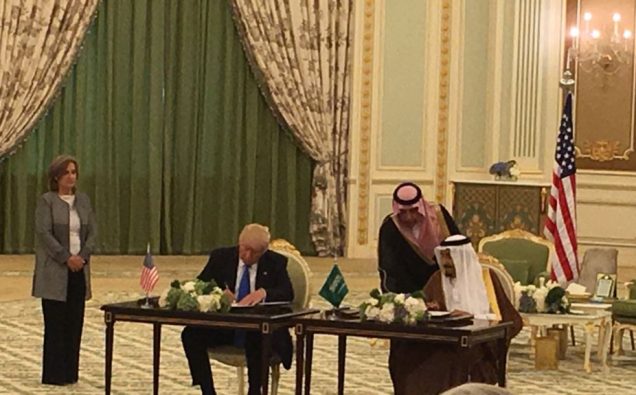
President Donald Trump and Saudi King Salman bin Abdulaziz sign agreement in Riyadh May 20, 2017 Photo: Courtesy Voice of America
In a key strategic development, the United States has agreed to a $ 350 billion arms sale deal with Saudi Arabia, the first country he is visiting since moving into the White House this year.
The $ 110 billion deal signed by the two sides will come into effect immediately and will likely include supply of major arms to the Kingdom, which accorded a royal welcome to President Trump.
“This package of defense equipment and services support the long-term security of Saudi Arabia and the Gulf region in the face of Iranian threats, while also bolstering the Kingdom’s ability to contribute to counter terrorism operations across the region, reducing the burden on the U.S. military to conduct those operations,” the White House said in a statement.
The Trump Administration is likely to showcase the massive deal as success of the president in deal-making, and creating opportunities for Americans.
But the deal has many implications for the broader Middle East region. On the one level, it anoints the conservative Saudi Kingdom as the leader of the Arab and the Muslim world.
On the other, it overturns his former president Barack Obama’s policy which sought to strike a balance in the region vis-à-vis U.S. relations with Saudi Arabia and Iran.
The move is likely to enrage Iran, which reelected moderate President Hassan Rouhani to carry on the reforms process. The Trump Administration has toughened U.S. policy toward Teheran. However, the Iran nuclear deal – concluded to stop Iran from developing atomic weapons and a major Obama foreign policy step– remains in place.
But in the United States, both countries are seen as conservatives and backers of militancy in the Middle Eastern war theaters. Post-911, the Saudi image has suffered deeply in the United States, as majority of the plane hijackers came from the country
In that context, President Trump’s visit and huge arms deal comes as a victory for King Salman bin Abdulaziz, and Mohammed bin Salman, the 31-year old deputy crown prince.
A White House readout of the meetings with Saudi leaders said the President’s meetings “underscored the deep and longstanding commitment of the United States to the security, stability, and prosperity of Saudi Arabia and demonstrated the President’s confidence in the future of U.S.-Saudi relations.”
The President emphasized the “importance of working jointly to address challenges to regional peace and security, including defeating ISIS and al-Qa’eda, countering Iran’s destabilizing activities, and resolving conflicts in Yemen and Syria.”
“The President and King Salman signed a Joint Strategic Vision Statement promising close collaboration to counter violent extremism, disrupt the financing of terrorism, and advance defense cooperation. Moreover, the President expressed his strong support for Saudi Arabia’s economic reform plans and promoted U.S. companies as ideal partners for Saudi Arabia’s economic transformation, as illustrated by the many deals signed by U.S. companies during the President’s visit,” the statement said.

















